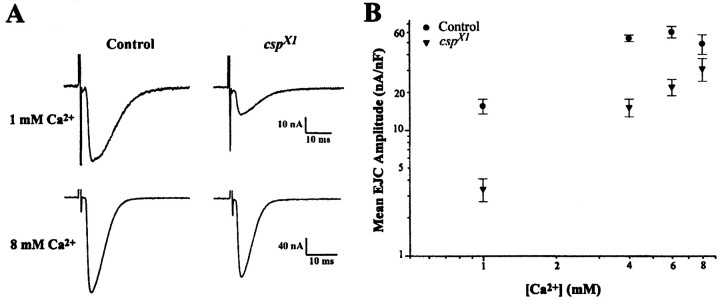Fig. 4.
Ca2+ dependence of evoked release elicited by single stimuli at 23°C in csp mutants. High [Ca2+]e restores the loss of evoked release at cspX1 mutant NMJs.A, Typical two-electrode voltage-clamp recordings of EJCs elicited at 0.2 Hz from larval NMJs in 1 and 8 mm[Ca2+]e. Each EJC represents an average of 20 trials. B, Recorded EJC amplitudes at the indicated [Ca2+]e were normalized for muscle size by dividing the current amplitude by the cell capacitance. Twenty trials were averaged for n larvae. Eachpoint represents the mean EJC amplitude of at least four larvae. Error bars indicate SEM. In 1, 4, and 6 mm[Ca2+]e,cspX1 amplitudes are significantly different from control (p < 0.007, Student'st test). In 8 mm[Ca2+]e,cspX1 mutant amplitudes are no longer significantly different from control (p = 0.15, Student's t test). Mean EJC amplitudes were 15.6 ± 2.1 nA/nF (mean ± SEM) for control and 3.4 ± 0.7 nA/nF forcspX1 mutants in 1 mm[Ca2+]e, and 49.1 ± 8.8 nA/nF for control and 31.1 ± 6.4 nA/nF forcspX1 mutants in 8 mm[Ca2+]e.

